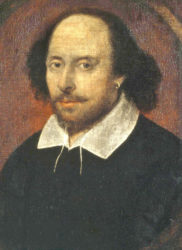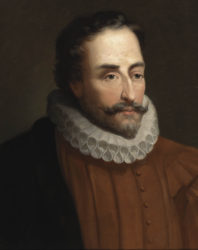April 23, 2016 is an extremely important anniversary on the world literary calendar. It is universally known as the anniversary of the death of William Shakespeare, but its significance is even greater than that. It also happens to be the anniversary of the death of another of the greatest writers in western literature. This year it is especially commemorated because it is the 400th anniversary of the death of both Shakespeare and Cervantes.
The very well known ‘Bard of Avon’ William Shakespeare (April 24, 1564 – April 23, 1616) who was born in Stratford, England, was the greatest writer of all time, writing in English. Miguel de Cervantes (September 29, 1547, circa, – April 23, 1616) was born in Alcalá de Henares, Spain, and was the greatest writer in Spanish. His birth year – 1547 – is not certain, and some sources say he died on the April 22, but it has gone down in history as April 23.

Cervantes’ extraordinary achievements were claimed as a novelist, although he was also a playwright, but struggled for a very long time to live by his art. So he worked in the service of king and country, as a tax collector and accountant, but mostly in a long military career. He was a war hero and was kidnapped by the Ottomans, enemies of Spain and kept prisoner from 1575 – 1580. For a long time he strove to rise out of poverty. Just as it was in the case of Shakespeare, there were episodes in his life that might be more myth than history as they have not been verified by fact or documented evidence. Included among those is that he fled to Italy to escape arrest by the aristocracy.
What is verified is that he did go to Italy and spent a number of years there. At that time, Italy was a virtual cultural capital to Europe, originating and contributing very much to literature, art and the theatre. Apart from being the native land of outstanding wits such as Boccaccio, Petrarch and Dante, it was exceedingly influential in what developed in poetry and the source of many tales. Shakespeare was greatly inspired as he set several of his plays in Italy – Venice, Naples, Verona.

Cervantes certainly developed himself in Italy as his writing career fluctuated. The most prosperous and settled period of his life was also his most prolific as a writer. This was the period 1605 -1616. He published Don Quixote Part I in 1605 to immediate acclaim, success, popularity and fame. He had returned and settled in Madrid ending lengthy nomadic periods, much like the picaresque heroes of many stories of the time – perhaps even Don Quixote. It was a highly celebrated return to his literary career. Don Quixote Part II was published in 1615, and thereafter both parts were kept together as a single novel.
El Ingenioso Hidalgo Don Quijote de la Mancha (The Ingenious Gentleman Don Quixote de la Mancha), which is the full name of the book, is regarded as the greatest novel of all time and is placed at the pinnacle of Cervantes’ success. It was also groundbreaking since it was a pioneer as a full length novel, preceded mainly by short stories and fairly conventional pieces of writing, dominated by the picaresque, sometimes violent and bloody like The Vengeance of Cutwolf or witty and humorous like I Caught The Bird, both by Thomas Nashe of England. Longer fiction, represented by Euphues by John Lyly (1553/54 – 1606), was limited by its ‘circumlocutous’ style which became known as Euphuism.
Cervantes wrote his great work of fiction as a critique of certain elements of society and styles of fiction that were popular at the time. In particular, he targeted chivalry and the literature of chivalry which included the courtly love tradition. He employed burlesque, picaresque and realism to ridicule those forms of literature, which he represented as madness. Indeed, his hero Don Quixote went mad from reading too much of this literature and imagined himself a knight going off in search of adventure and heroic conquests. He even recruited a ‘squire’ and pledged devotion to a damsel – a farm girl who he recreated as a lady. It is a tale of madness and a mock romantic, but it contains many very important commentaries about Spanish society of which Cervantes did not quite approve.
This novel became the most influential in Spanish Golden Age literature and even influenced the Spanish language. As if to prove its greatness and its widespread impact on the world, it has made itself immortal not only in literature in the English language, but on the English language itself. This language has a word – ‘quixotic’ used in everyday speech to describe someone of the eccentric and easily ticked off temperament of the Knight Errant Quixote of La Mancha. Additionally, there is a saying which is in common usage in English – ‘tilting at windmills,’ which is used to describe someone battling an imaginary problem, most often one that they have created but which really isn’t there.
Another phrase used for the same thing, ‘fighting a dragon that is not there’ also derives from Cervantes. These linguistic borrowings come from Quixote’s characteristic tendency to imagine adversaries that he had to fight against as a knight pledged to battle wrong and injustice. In one famous episode in the novel he wages a physical battle against a windmill that he thought was a dragon. Many times he gets himself into trouble by imagining that persons or things are the enemy to be attacked.
The very quotable quality of Cervantes’ work is similar to the work of Shakespeare, who has had an even greater influence on the English language. There are several sayings, idioms that have now become clichés from overuse in English speech that originated as high quality poetic turns of phrase in Shakespeare’s plays. They are numerous – to quote examples: ‘neither a borrower nor a lender be;’ and ‘to thine own self be true. And it must follow as the night the day, Thou canst not then be false to any man.’ Amazingly, those come from a single speech in Shakespeare’s Hamlet, very ironically spoken by a character Polonius, of whom the playwright disapproves.

Shakespeare’s greatness arises from many things. Apart from being so very quotable, his works have many traits of greatness. The Elizabethan Age was a truly great period in English literature during which the theatre advanced and flourished more than in any other era. Many outstanding dramatists emerged, as did theatres, companies and forms of drama. Against highly talented ‘university wits,’ writers who were scholars and university trained, Shakespeare arose to be the best – and so acknowledged by those same men. Acknowledgement even came from Ben Jonson who was a critic, not a friend of Shakespeare. Other greats of the era included the extraordinary talent of Christopher Marlowe and Thomas Kyd.
To have been the best in such company was a remarkable achievement. He rose from the work in the theatre itself. He worked as an actor before rising as a playwright, a director and a producer who also published his work. He learnt drama from the very boards he trod – from the theatre of his time that he so often used as a metaphor and reference points in his plays.
All the dramatists of that time drew from the Classics – the Greek forms of tragedy and comedy, and most of them were masters of one or two forms. Just as Marlowe learnt from the Greek tragedy as well as the mediaeval morality play and slapstick comedy, so did Shakespeare from the Greeks and the Roman forms. But more than any of the others, he made these forms his own. He was a great innovator to the point where there arose the ‘Shakespearean Tragedy,’ the ‘Shakespearean Comedy’ and the ‘Problem Play,’ which he created. He was a master of not two, but five different types of plays, if you add the ‘History’ and the ‘Roman’ plays to those three already mentioned.
Similarly, Shakespeare innovated the way the English sonnet was used to the point where there emerged the Shakespearean sonnet. He used conventions of the time but just as quickly broke the rules and was very original. There is his use of a very wide range of themes and issues treated in the drama. One may remember his deployment of blank verse and rhymed verse, and of soliloquy. Above all, he wrote for the stage in such a way that he could indulge popular tastes in bawdy sexuality, in witty banters and comic speeches and episodes. He also entertained the crowd – ‘the groundlings’ in the pits.
Those are some of the reasons why this anniversary of 400 years of Shakespeare and Miguel de Cervantes is so much celebrated and honoured. Shakespeare’s Globe Theatre was re-established when a company built the Shakespeare Globe in London just about where the original structure stood, modelling it exactly on the original. That company just concluded a world tour that took two years, travelling to several countries, including Guyana, to perform Hamlet. They started on the 450th anniversary of the Bard’s birth, April 24, 2014, and returned to London on the 400th anniversary of his death – April 23, 2016. That neat tribute was aptly complemented by the Bocas Literary Festival in Trinidad twinning him with Cervantes to honour two exceptional talents.




